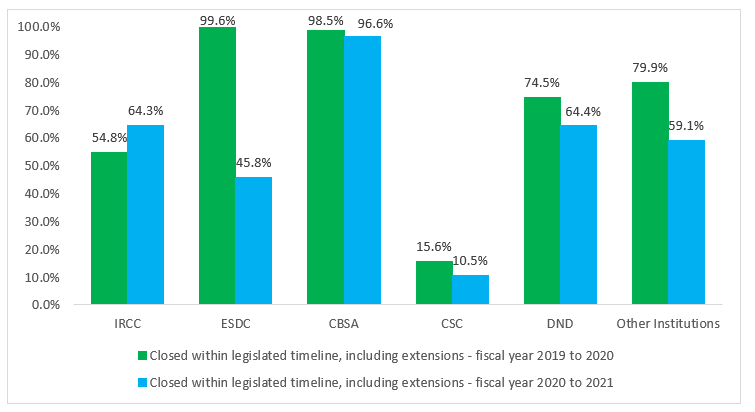Access to Information and Privacy Statistical Report for the 2020 to 2021 Fiscal Year
On this page
- Introduction
- Key observations
- Access to information and personal information requests during COVID-19
- Protecting personal information during COVID-19
- Access to Information Act statistics for the 2020 to 2021 fiscal year
- Privacy Act statistics for the 2020 to 2021 fiscal year
- Annex: detailed analysis
Introduction
Openness, transparency and accountability are guiding principles of the Government of Canada.
The Access to Information Act and the Privacy Act both came into effect on July 1, 1983.
Paragraph 70(1)(d) of the Access to Information Act assigns responsibility to the President of the Treasury Board, as the designated minister, to collect statistics on an annual basis. These statistics are used to assess the performance of the Government of Canada’s access to information and privacy programs.
This statistical report presents statistical information about the Government of Canada’s access to information and privacy programs globally across all federal institutions subject to the two Acts for the period of April 1, 2020, to March 31, 2021. An annex providing detailed analysis of the institutions receiving the greatest number of requests under each Act and the disproportionate impact these institutions have on overall performance of the Access to Information and Privacy programs across the government is included.
In addition, each institution subject to the Access to Information Act and the Privacy Act tables an individual annual report in Parliament on the administration of each Act in their institution. These reports can be found on the institutions’ websites.
The complete statistical dataset for the 2020 to 2021 fiscal year will be available in open format on the Government of Canada’s Open Data Portal.
Key observations
In this section
Access to information requests
The 2020 to 2021 fiscal year saw a decrease of 6.5 percent in the number of access to information (ATI) requests received and a decrease of 47.5 percent in the number of pages processed. The number of pages processed in the 2019 to 2020 fiscal year was higher than previous years due to one institution closing three requests on the same subject involving nearly 15 million pages in total. Similarly, the number of ATI requests for consultation between federal institutions decreased by 52.1 percent in the 2020 to 2021 fiscal year and the number of pages to be reviewed decreased by 48.6 percent.
While there was a decrease of 6.5 percent in the number of ATI requests closed in the 2020 to 2021 fiscal year, there was an increase of 2.2 percent in the total number of requests closed within legislated timelines, including extensions. This increase was largely due to data from one government institution – Immigration, Refugees and Citizenship Canada (IRCC) – which accounted for 77.1 percent of ATI requests closed government wide in the 2020 to 2021 fiscal year. When data from IRCC is excluded, there was a decrease in the number of requests closed within legislated timelines, including extensions, of 11.2 percent government wide from the 2019 to 2020 fiscal year. The percentage of institutions that met the expected performance standard of closing 90 percent of requests received within legislated timelines, including extensions also decreased. In 2020-21, 49.3 percent of institutions that closed a request met this standard, a decline of 11.6 percent.
The number of requests carried over to the 2021 to 2022 fiscal year increased by 34.2 percent. The increase in requests carried over adds to the backlog of requests to be processed within institutions, potentially adding to challenges institutions face in closing requests in a timely manner as new requests continue to be received.
The cost of operations of access to information and privacy (ATIP) offices related to the administration of the Access to Information Act increased by 14.3 percent in the 2020 to 2021 fiscal year.
Personal information requests
The 2020 to 2021 fiscal year saw an overall decrease of 5.2 percent in the number of personal information requests received and a decrease of 15 percent in the number of pages processed. Similarly, the number of personal information requests for consultation between federal institutions decreased by 32.3 percent in the 2020 to 2021 fiscal year and number of pages to be reviewed decreased by 38.2 percent.
There was a corresponding decrease of 6.1 percent in the number of personal information requests closed during the 2020 to 2021 fiscal year. However, the number of requests closed within legislated timelines, including extensions, decreased by 15.6 percent from the 2019 to 2020 fiscal year. The percentage of institutions that met the expected performance standard of closing 85 percent of requests received within legislated timelines, including extensions also decreased. In 2020-21, 53.5 percent of institutions that closed a request met this standard, a decline of 22.3 percent.
The number of personal information requests carried over to the 2021 to 2022 fiscal year increased by 21 percent.
The increase in requests carried over adds to the backlog of requests to be processed within institutions, potentially adding to challenges institutions face in closing requests in a timely manner as new requests continue to be received.
Paragraph 8(2)(m) of the Privacy Act permits the disclosure of personal information under the control of a government institution for any purpose where, in the opinion of the head of the institution, (i) the public interest in disclosure clearly outweighs any invasion of privacy that could result from the disclosure, or (ii) disclosure would clearly benefit the individual to whom the information relates. The number of disclosures of personal information citing this provision increased by 1,713 percent. The increase was largely attributable to Correctional Services Canada, related to disclosures made to public health authorities following COVID-19 outbreaks at correctional institutions.
The cost of operations of ATIP offices related to the administration of the Privacy Act increased by 12.6 percent in the 2020 to 2021 fiscal year.Access to information and personal information requests during COVID-19
The COVID-19 pandemic had an impact on institutions’ ability to respond to access to information and personal information requests in the 2020 to 2021 fiscal year. In response to public health direction on COVID-19, most employees were working remotely, without full access to documents and to the entirety of the information systems that they would use to respond to requests. There are, however, no provisions in the Access to Information Act or the Privacy Act to extend deadlines or place requests on hold due to an emergency.
The Government of Canada was, and remains, committed to maintaining the openness and transparency of government during this challenging time. In May 2020, former President of the Treasury Board, Jean-Yves Duclos, wrote to his Cabinet colleagues encouraging Ministers to proactively publish as much information as possible related to COVID-19 and remind them of the importance of ensuring best practices in information management.
To support the government-wide administration of access to information (ATI) and personal information requests, the Treasury Board of Canada Secretariat (TBS) took a number of steps.
Treasury Board of Canada Secretariat worked with institutions subject to the Acts to identify what tools and capacities were needed to improve their ability to process requests remotely and whether investments in new technology could assist in addressing any backlog as a result of COVID-19 restrictions. The lessons learned throughout this process have been shared with ATIP Offices.
Institutions also heeded the call to proactively publish as much information as possible related to COVID-19. As of March 31, 2021, thirty Government of Canada institutions had published 441 COVID-related open information and open data records on the Open Government Portal (open.canada.ca).
In Budget 2021, the Government committed significant new funding to improving and reviewing the ATI program. This funding will be used to improve the systems that support access to information and privacy requests, helping institutions to address outstanding requests and continually improve ATI program performance. In addition, work is underway to ensure that modern ATIP request processing software is available to government institutions.
Protecting personal information during COVID-19
Early in the pandemic, TBS issued a Privacy Implementation Notice on collecting and disclosing employees’ personal information related to COVID-19. It addressed questions regarding what medical information institutions could collect about their employees, and when. It also provided information as to whether they could share employees’ medical information in the case of an outbreak and when consent to disclose was required.
To support the Government’s commitment to privacy protection while implementing urgent COVID-19 initiatives, TBS issued an Interim Policy on Privacy Protection, Interim Directive on Privacy Practices, and Interim Directive on Privacy Impact Assessment in June 2020. These remained in effect until March 31, 2021. Under the interim policy and directives, institutional heads had the discretion to complete a Privacy Compliance Evaluation in place of a full Privacy Impact Assessment for COVID-19 urgent initiatives. For initiatives that continued beyond March 31, 2021, institutions were required to complete a full Privacy Impact Assessment by September 30, 2021. In total, eight federal institutions submitted 18 Privacy Compliance Evaluations on key government programs including: ArriveCAN, Quarantine compliance, Rapid-testing pilots, and e-Post for the delivery of identity and travel documents of refugees. A survey of institutions who used Privacy Compliance Evaluations found the flexibility offered by the tool saved time and resources, encouraged more interaction between privacy and program teams, and enabled privacy considerations to be included in program implementation where otherwise they may not have been.
Access to Information Act statistics for the 2020 to 2021 fiscal year
In this section
Requests under the Access to Information Act
The number of ATI requests received during the 2020 to 2021 fiscal year decreased 6.6 percent from the 2019 to 2020 fiscal year. However, in the 2020 to 2021 fiscal year, the number of ATI requests that were outstanding from the previous fiscal year increased by 28.5 percent.
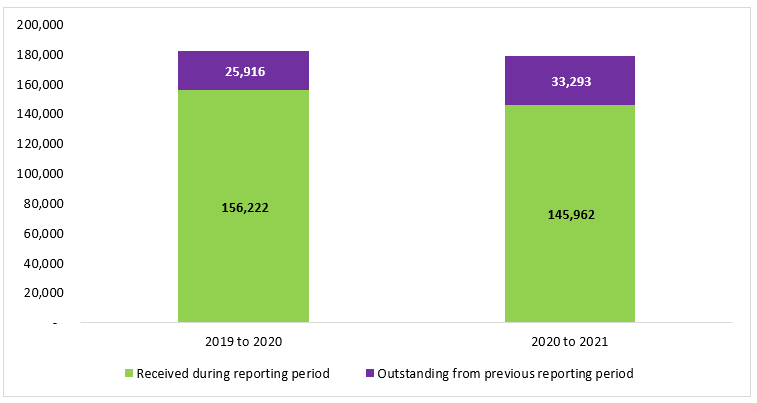
Of all the ATI requests that were either received in the 2020 to 2021 fiscal year or outstanding from the previous fiscal year, 75.6 percent were closed. This is a decrease of 6.5 percent from the 2019 to 2020 fiscal year.
Note: Due to administrative errors, there are small inconsistencies between the number of requests carried over from the 2019 to 2020 fiscal year and the number of outstanding requests in the 2020 to 2021 fiscal year.
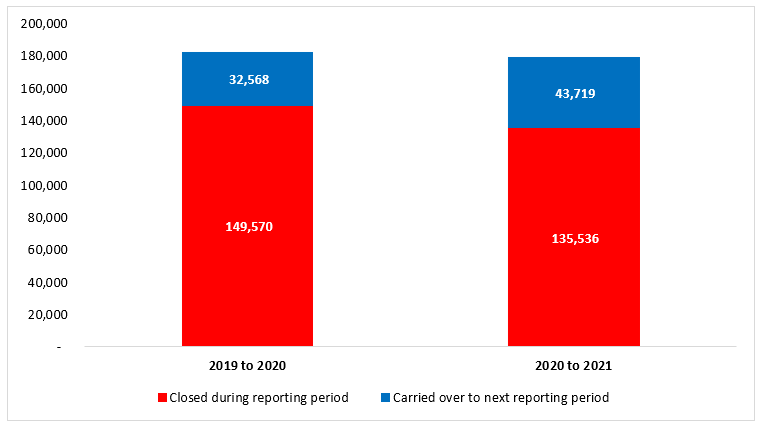
There was an increase of 34.2 percent of the number of requests carried over to the next reporting period.
Five government institutions received 124,957 of the 145,962 requests received in the 2020 to 2021 fiscal year, or 85.6 percent of all requests.
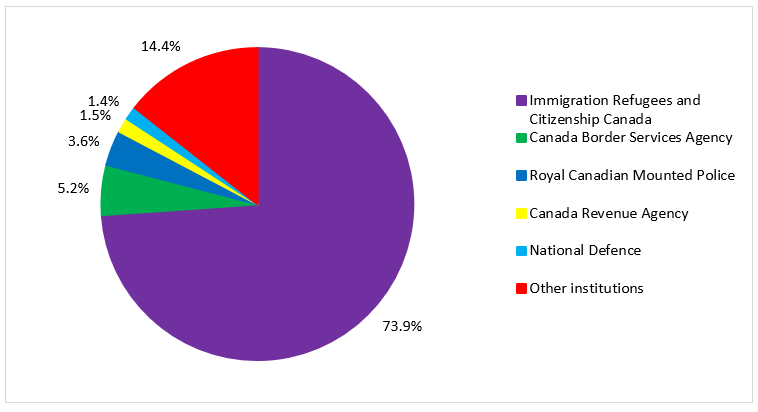
Timeliness
Of the 135,536 ATI requests closed in the 2020 to 2021 fiscal year, 69.6 percent were closed within the legislated timeline, including extensions. This is an increase of 2.2 percent from the 2019 to 2020 fiscal year. This increase was largely due to data from one government institution – Immigration, Refugees and Citizenship Canada (IRCC) – which accounted for 77.1 percent of ATI requests closed in the 2020 to 2021 fiscal years.
Of the 104,547 ATI requests that were closed by IRCC, 71 percent were closed within the legislated timelines, including extensions. This is an increase of 6.6 percent from the 2019 to 2020 fiscal year.
For all other government institutions, of the 30,989 ATI requests that were closed in the 2020 to 2021 fiscal year, 65.1 percent were closed within the legislated timeline, including extensions. This is a decrease of 11.2 percent from the 2019 to 2020 fiscal year.
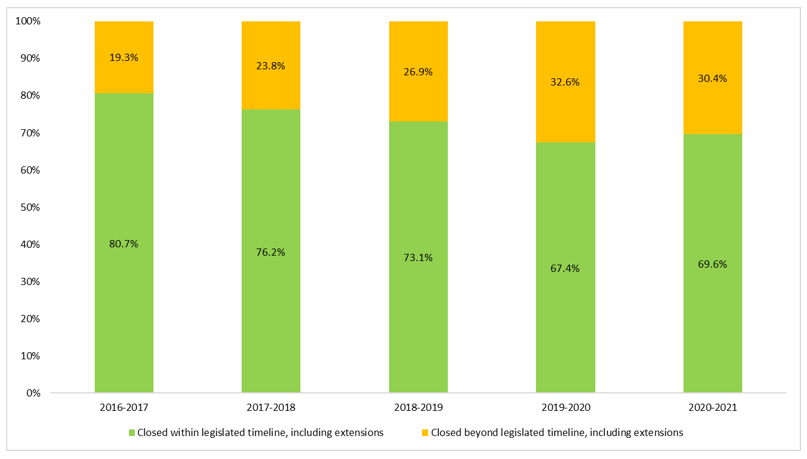
The performance standard for institutions is to respond to 90 percent of ATI requests within the legislated timeline, including extensions. Of the 140 institutions that closed ATI requests in the 2020 to 2021 fiscal year, 69 institutions met this standard. 71 institutions did not meet this standard, principally due to workload pressures within the organization. Of the 42 institutions that did not close any requests in the 2020 to 2021 fiscal year, 40 institutions did not receive any requests and 2 institutions received requests that were carried over to the 2021 to 2022 reporting year.
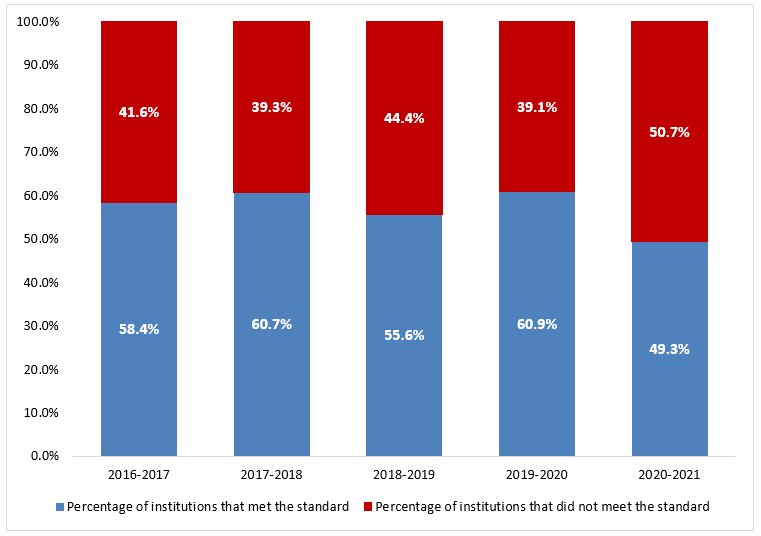
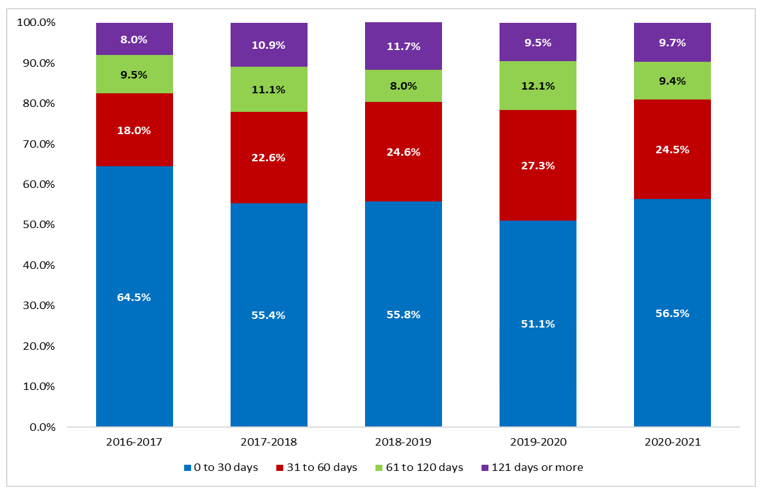
| Principal reason | Total number of requests closed beyond the legislated timeline, including extensions |
|---|---|
| Workload | 35,422 |
| External consultation | 445 |
| Internal consultation | 302 |
| Othertable 1 note a | 5,008 |
| Total | 41,177 |
Table 1 Notes
|
|
Disposition
Records were all disclosed or disclosed in part in response to 87.4 percent of closed ATI requests. This is a decrease of 0.6 percent from the 2019 to 2020 fiscal year.
In the 2020 to 2021 fiscal year, institutions reported seeking the Information Commissioner’s approval to decline to act on 6 requests. Subsequently, institutions withdrew the application to decline to act on 5 requests. The decision regarding the last request was carried over to the 2021 to 2022 reporting period.
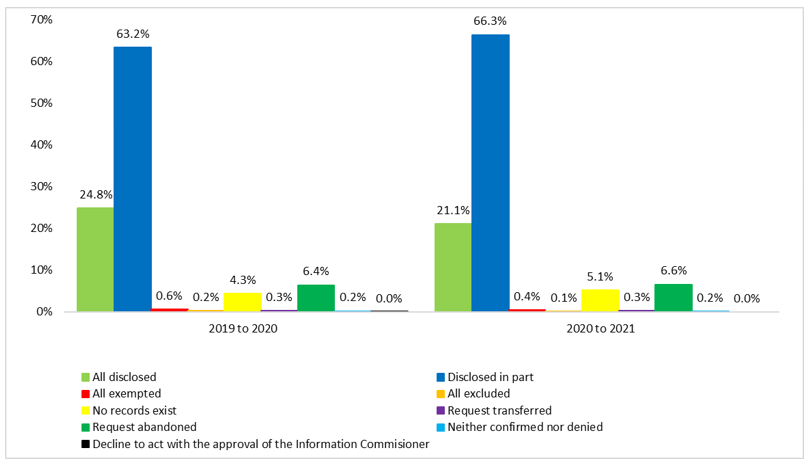
Complexity
One key aspect of complexity is the number of pages processed in response to ATI requests. During the 2020 to 2021 fiscal year, five institutions processed 77.9 percent of the 17,115,061 total pages processed in response to closed ATI requests.
| Rank | Name of institution | Number of requests closed | Number of pages processed table 2 note a | Number of pages disclosed |
|---|---|---|---|---|
| 1 | Immigration, Refugees and Citizenship Canada | 104,547 | 9,486,193 | 7,826,303 |
| 2 | Canada Revenue Agency | 2,319 | 1,804,108 | 1,381,282 |
| 3 | Canada Border Services Agency | 7,261 | 964,633 | 726,152 |
| 4 | Royal Canadian Mounted Police | 3,430 | 560,275 | 214,419 |
| 5 | Canadian Radio-Television and Telecommunications Commission | 85 | 521,761 | 26,092 |
| Other institutions | 17,894 | 3,778,091 | 2,244,995 | |
| Total | 135,536 | 17,115,061 | 12,418,973 | |
Table 2 Notes
|
||||
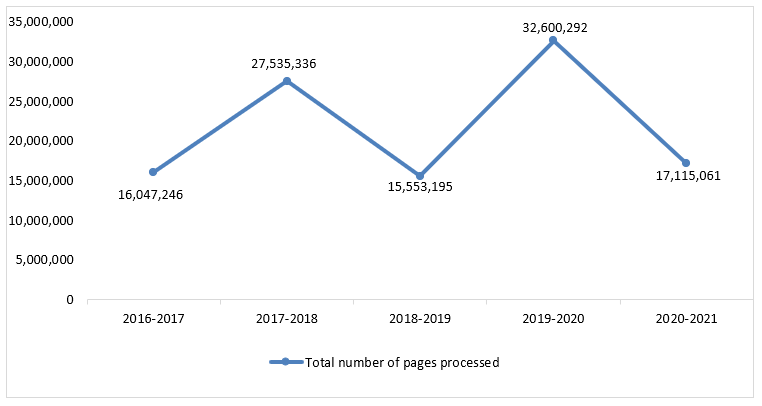
Note: The number of pages processed rose significantly in the 2017 to 2018 fiscal year due to 1 request of approximately 14.8 million pages. The number of pages once again rose significantly in the 2019 to 2020 fiscal year due to one institution closing three requests on the same subject involving nearly 15 million pages in total.
An additional key aspect of complexity is requests that require consultations with other institutions. During the 2020 to 2021 fiscal year, government institutions undertook consultations in 3.3 percent of all closed ATI requests. This is a decrease of 3.1 percent from the 2019 to 2020 fiscal year.
| Disposition | Consultation required | Assessment of fees | Legal advice sought | Othertable 3 note a | Total |
|---|---|---|---|---|---|
| All disclosed | 603 | 26 | 17 | 250 | 896 |
| Disclosed in part | 3,448 | 22 | 236 | 640 | 4,346 |
| All exempted | 72 | 3 | 16 | 38 | 129 |
| All excluded | 45 | 5 | 10 | 15 | 75 |
| Request abandoned | 292 | 3 | 20 | 185 | 500 |
| Neither confirmed nor denied | 1 | - | 3 | - | 4 |
| Decline to act with the approval of the Information Commissioner | - | - | - | - | - |
| Total | 4,461 | 59 | 302 | 1,128 | 5,950 |
Table 3 Notes
|
|||||
Extensions
49.1 percent of all extensions taken cited paragraph 9(1)(a) of the Access to Information Act as a reason for the extension, relating to interference with government operations. 13.6 percent of all extensions taken for closed requests were for 30 days or less; 91.2 percent were for 120 days or less.
| Length of extensionstable 4 note a | 9(1)(a) - Interference with operations | 9(1)(b) - Consultation | 9(1)(c) - Third-party notice | Total | |
|---|---|---|---|---|---|
| Section 69table 4 note b | Othertable 4 note c | ||||
| 30 days or less | 1,781 | 27 | 616 | 92 | 2,516 |
| 31 to 60 days | 2,089 | 56 | 4,717 | 1,260 | 8,122 |
| 61 to 120 days | 4,338 | 227 | 1,303 | 318 | 6,186 |
| 121 to 180 days | 563 | 48 | 259 | 51 | 921 |
| 181 to 365 days | 217 | 27 | 324 | 30 | 598 |
| More than 365 days | 74 | 4 | 16 | 5 | 99 |
| Total | 9,062 | 389 | 7,235 | 1,756 | 18,442 |
Table 4 Notes
|
|||||
Exemptions
The most frequently applied exemption for the ATI requests closed in the fiscal year 2020 to 2021 is subsection 19(1), which related to the protection of personal information and was applied in approximately 57 percent of all closed requests.Footnote 1
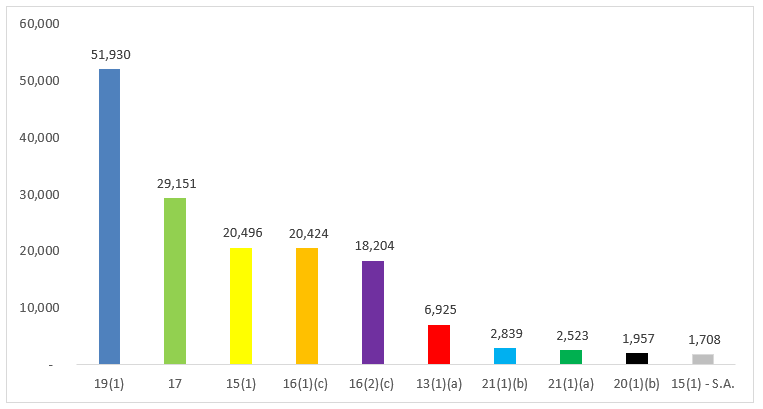
Figure 9 - Text version
| Exemption | Description |
|---|---|
| 19(1) | Personal Information |
| 17 | Safety of individual |
| 15(1) | International affairs and defence |
| 16(1)(c) | Law enforcement and investigations – information expected to be injurious to the enforcement of any law of Canada |
| 16(2)(c) | Security – Information on the vulnerability of particular buildings or other structures or systems |
| 13(1)(a) | Information obtained in confidence from the government of a foreign state |
| 21(1)(b) | An account of consultations or deliberations |
| 21(1)(a) | Advice or recommendations |
| 20(1)(b) | Third party information – confidential financial, commercial, scientific, or technical information |
| 15(1) – S.A. | International affairs and defence – military information relating to the detection, prevention or suppression of subversive or hostile activities |
Exclusions
Specific categories of information are excluded from the right of access pursuant to the Access to Information Act; exclusions for non-application (s.68, 68.1 and 68.2), confidences of the Queen’s Privy Council for Canada (s.69), and for certificates under the Canada Evidence Act (s.69.1).
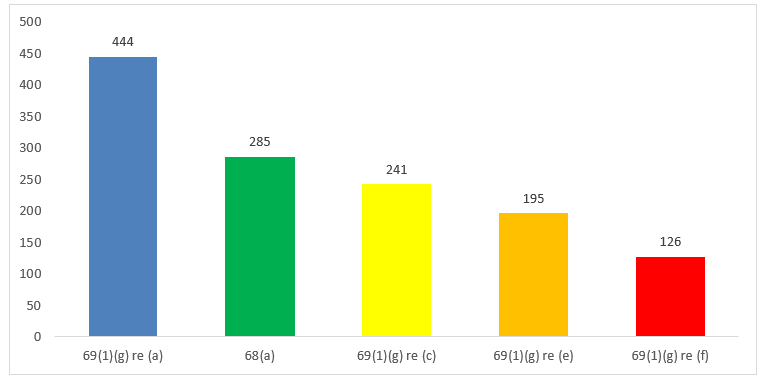
Consultations between federal institutions
The number of ATI requests for consultation between federal government institutions decreased by 52.1 percent in the 2020 to 2021 fiscal year. The number of pages to review decreased by 48.6 percent.
| Consultations | Number of requests for consultations | Number of pages to review | ||
|---|---|---|---|---|
| 2019 to 2020 | 2020 to 2021 | 2019 to 2020 | 2020 to 2021 | |
| Received during reporting period | 10,187 | 4,879 | 402,943 | 207,076 |
| Outstanding from the previous reporting period | 1,759 | 1,917 | 227,884 | 261,759 |
| Total | 11,946 | 6,796 | 630,827 | 468,835 |
| Closed during the reporting period | 9,980 | 4,810 | 435,841 | 260,526 |
| Pending at the end of the reporting period | 1,966 | 1,986 | 195,021 | 208,309 |
| Number of days required to close consultation requests | ||||||||
|---|---|---|---|---|---|---|---|---|
| 1 to 15 days | 16 to 30 days | 31 to 60 days | 61 to 120 days | 121 to 180 days | 181 to 365 days | More than 365 days | Total | |
| Total | 1,495 | 1,051 | 862 | 589 | 227 | 343 | 243 | 4,810 |
Fees and costs
The annual cost to administer the Government of Canada’s access to information program increased by 14.3 percent to about $89.7 million in the 2020 to 2021 fiscal year.
| Description | Amount | |
|---|---|---|
| 2019 to 2020 | 2020 to 2021 | |
| Cost of institutions’ operationstable 7 note a | $77,469,191 | $88,932,097 |
| Cost of ATIP Online Request Service | $987,919 | $752,212 |
| Total | $78,457,110 | $89,684,309 |
| Number of requests in which fees were collected | 148,791 | 135,803 |
| Fees collected | $743,955 | $679,015 |
| Number of requests in which fees were waived or refunded | 5,584 | 6,189 |
| Fees waived or refunded | $35,319 | $30,945 |
Table 7 Notes
|
||
Informal requests for government information
An informal request is a request for information made to a government institution subject to the Access to Information Act that is either not made or not processed under the Act.
Informal requests include:
- formal requests that are discontinued in favour of providing information informally, in consultation with the requester
- requests where the information sought is already publicly available online
- requests where the response involves re-releasing information that was made available in response to previously closed formal requests, summaries of which are found online.
Informal requests do not include:
- responses to parliamentary questions or media enquiries
- requests made internally within a government institution to share information between sectors
Unlike in the case of formal requests:
- fees cannot be charged for informal requests
- there are no deadlines for responding to informal requests
- requesters have no statutory right of complaint to the Information Commissioner
In the 2020 to 2021 fiscal year, 53.2 percent of informal requests were closed within 30 days. This is a decrease of 5.2 percent from the 2019 to 2020 fiscal year.
| Closure time | ||||||||
|---|---|---|---|---|---|---|---|---|
| 1 to 15 days | 16 to 30 days | 31 to 60 days | 61 to 120 days | 121 to 180 days | 181 to 365 days | More than 365 days | Total | |
| Number of requests | 5,620 | 1,431 | 1,875 | 1,622 | 680 | 1,125 | 911 | 13,264 |
Privacy Act statistics for the 2020 to 2021 fiscal year
In this section
- Requests under the Privacy Act
- Timeliness
- Disposition
- Complexity
- Extensions
- Exemptions
- Exclusions
- Consultations between federal institutions
- Costs
- Disclosures under subsections 8(2) and 8(5) of the Privacy Act
- Requests for correction of personal information and notations
- Privacy impact assessments
- Personal information banks
- Material Privacy Breaches
Requests under the Privacy Act
The number of personal information requests received during the 2020 to 2021 fiscal year decreased 5.2 percent from the 2019 to 2020 fiscal year. However, in the 2020-2021 fiscal year, the number of personal information requests that were outstanding from the previous fiscal year increased by 15.6 percent.
Of all the personal information requests that were either received in 2020 to 2021 fiscal year or outstanding from the previous fiscal year, 64 percent were closed. This is a decrease of 6.1 percent from the 2019 to 2020 fiscal year.

Note: Due to administrative errors, there are small inconsistencies between the number of requests carried over from the 2019 to 2020 fiscal year and the number of outstanding requests in the 2020 to 2021 fiscal year.
There was an increase of 21 percent in the number of requests carried over to the next reporting period.
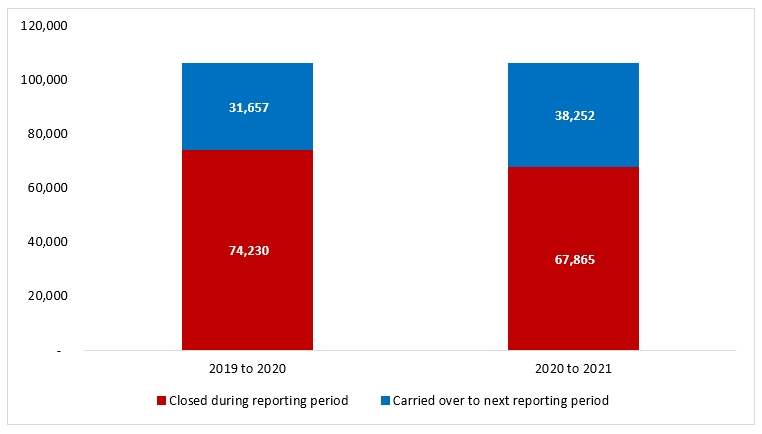
Five government institutions received 56,851 of the 74,494 personal information requests received in the 2020 to 2021 fiscal year or 76.3 percent of all requests.
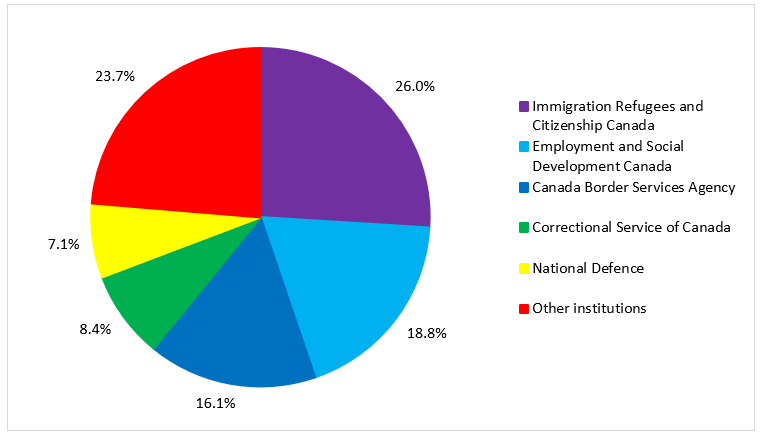
Timeliness
Of the 67,865 personal information requests closed in the 2020 to 2021 fiscal year, 63.3 percent were closed within the legislated timeline, including extensions. This is a decrease of 15.6 percent from the 2019 to 2020 fiscal year.
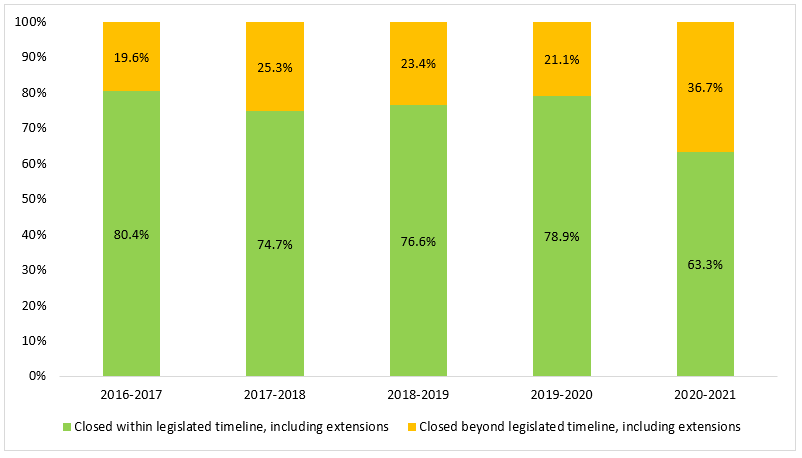
The established performance standard for institutions is to respond to 85 percent of personal information requests within the legislated timeline, including extensions. Of the 99 institutions that closed personal information requests in the 2020 to 2021 fiscal year, 53 institutions met this standard. 46 institutions did not meet this standard, principally due to workload pressures within the organization. Of the 83 institutions that did not close any requests in the 2020 to 2021 fiscal year, 80 institutions did not receive any requests and 3 institutions received requests that were carried over to the 2021 to 2022 reporting year.

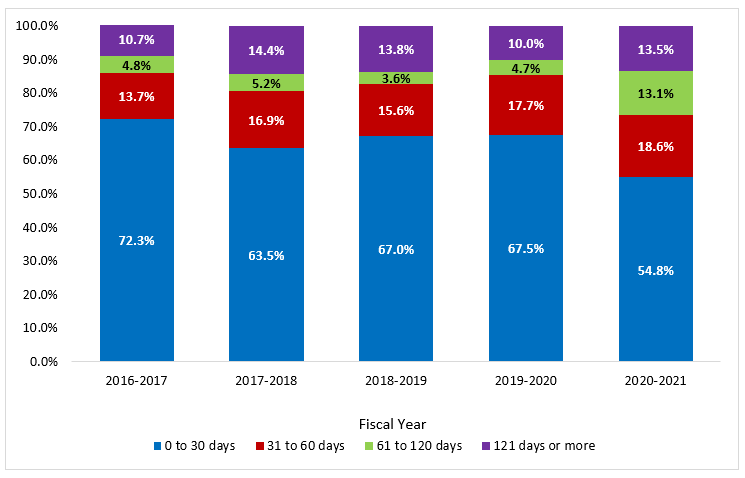
| Principal reason | Total number of requests closed beyond the legislated timeline, including extensions |
|---|---|
| Workload | 13,152 |
| External consultation | 43 |
| Internal consultation | 63 |
| Othertable 9 note a | 11,627 |
| Total | 24,885 |
Table 9 Notes
Note: Deemed refusals are requests that were not closed in the initial 30-day legislated timeframe or within the timeframe covered by an extension. |
|
Disposition
Records were all disclosed or disclosed in part for 75.9 percent of closed personal information requests. This is an increase of 0.5 percent from the 2019 to 2020 fiscal year.
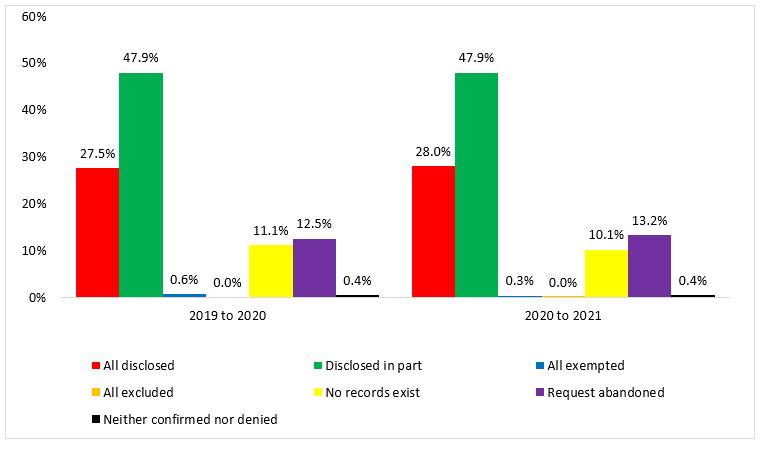
Complexity
One key aspect of complexity is the number of pages processed in response to personal information requests. During the 2020 to 2021 fiscal year, five institutions processed 66.6 percent of the 7,893,700 total pages processed in response for personal information requests.
| Rank | Name of Institution | Number of requests closed | Number of pages processed | Number of pages disclosed |
|---|---|---|---|---|
| 1 | Immigration Refugees and Citizenship Canada | 18,687 | 1,714,984 | 1,561,495 |
| 2 | Employment and Social Development Canada | 12,883 | 1,164,618 | 1,084,070 |
| 3 | National Defence | 4,904 | 1,050,543 | 971,771 |
| 4 | Library and Archives of Canada | 1,232 | 669,501 | 228,595 |
| 5 | Canada Revenue Agency | 4,023 | 653,853 | 538,726 |
| Other institutions | 26,136 | 2,640,201 | 1,647,225 | |
| Total | 67,865 | 7,893,700 | 6,031,882 | |
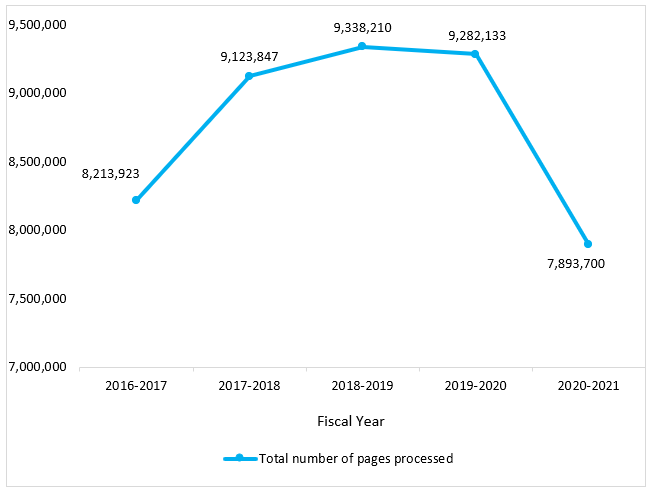
Additional key aspects of complexity are requests that require consultation, where legal advice is sought or when personal information is interwoven throughout the records.
| Disposition | Consultation required | Legal advice sought | Interwoven informationtable 11 note a | Othertable 11 note b | Total |
|---|---|---|---|---|---|
| All disclosed | 15 | 3 | 113 | 341 | 472 |
| Disclosed in part | 335 | 30 | 9,827 | 494 | 10,686 |
| All exempted | 5 | 3 | 4 | 8 | 20 |
| All excluded | 0 | 0 | 0 | 87 | 87 |
| Request abandoned | 10 | 5 | 49 | 107 | 171 |
| Neither confirmed nor denied | 8 | 0 | 0 | 0 | 8 |
| Total | 373 | 41 | 9,993 | 1,037 | 11,444 |
Table 1 Notes
|
|||||
Extensions
83.3 percent of all extensions taken for closed requests cited paragraph 15(a)(i) of the Privacy Act as a reason for the extension, relating to interference with government operations.
| Length of extensiontable 12 note a | 15(a)(i): Interference with operations | 15(a)(ii): Consultation | 15(b): Translation purposes or conversion | Total | |||||
|---|---|---|---|---|---|---|---|---|---|
| Further review required to determine exemptions | Large volume of pages | Large volume of requests | Documents are difficult to obtain | Cabinet Confidence (Section 70) table 12 note b | External | Internal | |||
| 1 to 15 days | 1 | 15 | 1 | 3 | 0 | 3 | 0 | 0 | 23 |
| 16 to 30 days | 158 | 432 | 6,243 | 417 | 0 | 127 | 1,318 | 10 | 8,705 |
| 31 days or greater | N/A | N/A | N/A | N/A | N/A | N/A | N/A | 1 | 1 |
| Total | 159 | 447 | 6,244 | 420 | 0 | 130 | 1,318 | 11 | 8,729 |
Table 12 Notes
|
|||||||||
Exemptions
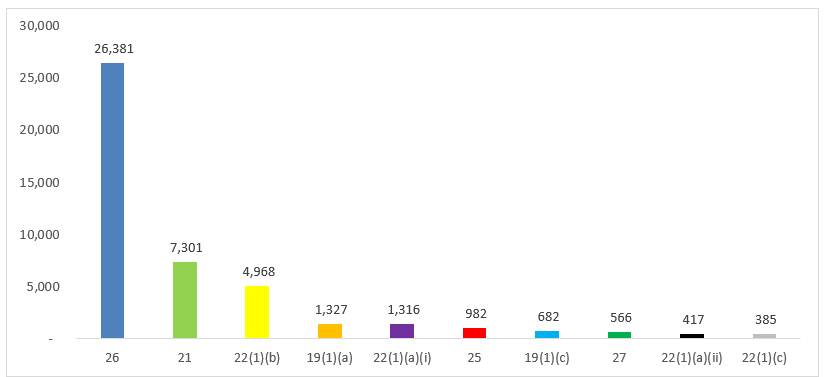
Figure 19 - Text version
| Exemption | Description |
|---|---|
| 26 | Information about another individual |
| 21 | International affairs and defence |
| 22(1)(b) | Law enforcement and investigations – information expected to be injurious to the enforcement of any law of Canada |
| 19(1)(a) | Information obtained in confidence from the government of a foreign state |
| 22(1)(a)(i) | Law enforcement and investigations – pertaining to the prevention or suppression of crime |
| 25 | Safety of individuals |
| 19(1)(c) | Information obtained in confidence from the government of a province |
| 27 | Solicitor-client privilege |
| 22(1)(a)(ii) | Law enforcement and investigations – pertaining to the enforcement of any law of Canada or a province |
| 22(1)(c) | Law enforcement and investigations – information expected to be injurious to the security of penal institutions |
Exclusions
Specific categories of information are excluded from the right of access pursuant to the Privacy Act; exclusions for non-application (69(1)(a) and 69(1)(b)), exclusions for Canadian Broadcasting Corporation (69.1), confidences of the Queen’s Privy Council for Canada (70(1), 70(1)(a), 70(1)(b), 70(1)(c), 70(1)(d), 70(1)(e) and 70(1)(f), and for certificates under the Canada Evidence Act (70.1).
During the 2020 to 2021 fiscal year, exclusions were applied to nine (9) closed personal information requests.
| Provision | Number of requests |
|---|---|
| 69(1)(a) – library and museum material | 4 |
| 69(1)(b) – material place by or on behalf of persons or organizations other than government institutions | 1 |
| 69.1 – personal information used for journalistic, artistic, or literary purposes by Canadian Broadcasting Corporation | 3 |
| 70(1) – Confidences of the Queen’s Privy Council for Canada | 1 |
Consultations between federal institutions
The number of personal information consultation requests between federal government institutions decreased by 32.3 percent from the 2019 to 2020 fiscal year. The number of pages to review decreased by 38.2 percent.
| Consultations | Number of requests for consultation | Number of pages to review | ||
|---|---|---|---|---|
| 2019 to 2020 | 2020 to 2021 | 2019 to 2020 | 2020 to 2021 | |
| Received during reporting period | 378 | 256 | 16,869 | 10,432 |
| Outstanding from the previous reporting period | 31 | 30 | 37,386 | 4,118 |
| Total | 409 | 286 | 54,255 | 14,550 |
| Closed during the reporting period | 382 | 232 | 50,091 | 10,676 |
| Pending at the end of the reporting period | 27 | 54 | 4,164 | 3,874 |
| Recommendation | Number of days required to close consultation requests | |||||||
|---|---|---|---|---|---|---|---|---|
| 1 to 15 days | 16 to 30 days | 31 to 60 days | 61 to 120 days | 121 to 180 days | 181 to 365 days | More than 365 days | Total | |
| Total | 95 | 64 | 35 | 25 | 7 | 3 | 3 | 232 |
Table 15 Notes
|
||||||||
Costs
The cost to administer the Government of Canada’s privacy program increased by 12.6 percent to about $62 million in the 2020 to 2021 fiscal year.
| Description of costs | Amount | |
|---|---|---|
| 2019 to 2020 | 2020 to 2021 | |
| Cost of institutions’ operationstable 16 note a | $54,607,942 | $61,698,661 |
| Cost of ATIP Online Request Service | $384,191 | $219,543 |
| Total | $54,992,133 | $61,918,204 |
Table 16 Notes
|
||
Disclosures under subsections 8(2) and 8(5) of the Privacy Act
Subsection 8(2) of the Act, subject to other Acts of Parliament, provides for the disclosure of personal information without the consent of the individual. Subsection 8(5) of the Act requires institutions to notify the Privacy Commissioner in writing of any disclosure of personal information made pursuant to paragraph 8(2)(m) of the Act. These notifications should be done prior to the disclosure where reasonably practical or in any other cases forthwith.
In the 2020 to 2021 fiscal year, the number of disclosures pursuant to subsection 8(2)(e) decreased 43.4 percent from the 2019 to 2020 fiscal year. Whereas the number of disclosures pursuant to paragraph 8(2)(m) increased more than 1,700 percent. This increase is largely due to one institution (Correctional Services Canada), which accounts for 91.1 percent of all disclosures pursuant to 8(2)(m).
| Paragraph 8(2)(e)table 17 note a | Paragraph 8(2)(m)table 17 note b | Subsection 8(5) | Total | |||||
|---|---|---|---|---|---|---|---|---|
| 3,217 | 4,169 | 303 | 7,689 | |||||
Table 17 Notes
|
||||||||
Requests for correction of personal information and notations
During the 2020 to 2021 fiscal year, 30.3 percent of all requests for correction pursuant to subsection 12(2) of the Privacy Act were accepted. In instances where correction was requested but not made, a notation was added to the information in question.
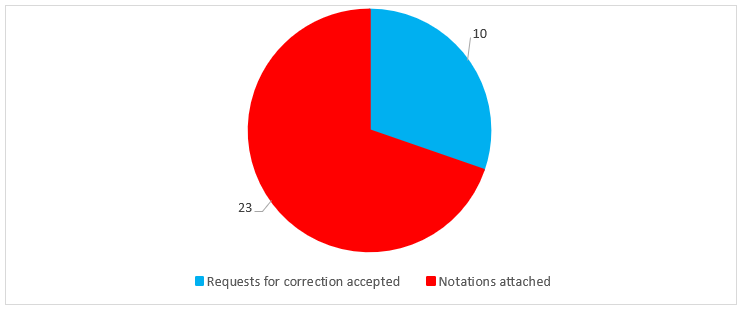
Privacy impact assessments
Privacy impact assessments (PIAs) provide a framework to ensure that privacy is considered throughout the design or redesign of programs or service delivery. PIAs identify the extent to which proposals comply with all appropriate statutes, assist managers and decision makers in avoiding or mitigating privacy risks, and promote informed policy, program and system design choices.
Completed PIAs must be submitted to the Treasury Board of Canada Secretariat, as well as to the Office of the Privacy Commissioner.
| Privacy impact assessments | Amount |
|---|---|
| Number of PIAs completedtable 18 note a | 102 |
Table 18 Notes
|
|
Personal information banks
Personal information banks (PIBs) are descriptions of personal information held by government institutions. The Privacy Act requires that PIBs describe all personal information about individuals that is organized and retrievable by a person’s name or by an identifying number, symbol or other particular assigned only to that person. PIBs must include personal information that has been or is being used, or is available for use, to support a program or activity.
| Personal information banks | Amount |
|---|---|
| Active | 2,833 |
| Created | 25 |
| Modified | 150 |
| Terminated | 13 |
Material Privacy Breaches
A breach is deemed a “material privacy breach” if the breach involves sensitive personal information and could reasonably be expected to cause serious injury or harm to the individual and/or involves a large number of affected individuals. Section 4 of the Guidelines for Privacy Breaches requires institutions to establish a process for the mandatory reporting of material privacy breaches to the Office of the Privacy Commissioner (OPC) and the Treasury Board of Canada Secretariat (TBS).
During the 2020 to 2021 fiscal year, government institutions reported 250 material privacy breaches to both the Treasury Board of Canada Secretariat and the Office of the Privacy Commissioner of Canada.
Annex: detailed analysis
Requests under the Access to Information Act
In the 2020 to 2021 fiscal year, five institutions received 85.6 percent of all Access to Information Act request received by all federal institutions. These five institutions are Immigration, Refugees and Citizenship Canada (IRCC), the Canada Border Services Agency (CBSA), the Royal Canadian Mounted Police (RCMP), the Canada Revenue Agency (CRA), and the Department of National Defence (DND). To provide a more detailed understanding of the access to information program, this Annex provides data for these five institutions.
The number of requests received by these institutions decreased by 7.1 percent since the last fiscal year, from 134,499 in the 2019 to 2020 fiscal year to 124,957 in the 2020 to 2021 fiscal year.
The number of requests received by all other institutions decreased by 3.3 percent since the last fiscal year, from 21,723 in the 2019 to 2020 fiscal year to 21,005 in the 2020 to 2021 fiscal year.
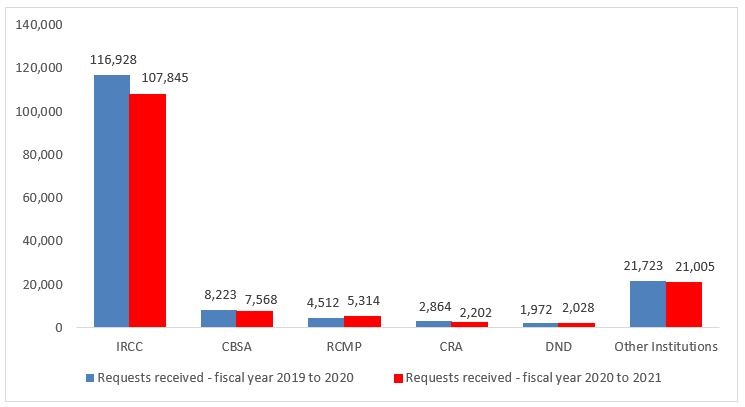
The number of requests closed by the five institutions who received the most requests decreased by 7.4 percent since the last fiscal year, from 128,955 in the 2019 to 2020 fiscal year to 119,445 in the 2020 to 2021 fiscal year.
The number of requests closed by all other institutions decreased by 21.9 percent since the last fiscal year, from 20,615 in the 2019 to 2020 fiscal year to 16,091 in the 2020 to 2021 fiscal year.

The number of requests carried over by the five institutions who received the most requests increased by 25.9 percent since the last fiscal year, from 23,792 in the 2019 to 2020 fiscal year to 29,957 in the 2020 to 2021 fiscal year.
The number of requests carried over by all other institutions increased by 56.8 percent since the last fiscal year, from 8,776 in the 2019 to 2020 fiscal year to 13,762 in the 2020 to 2021 fiscal year.
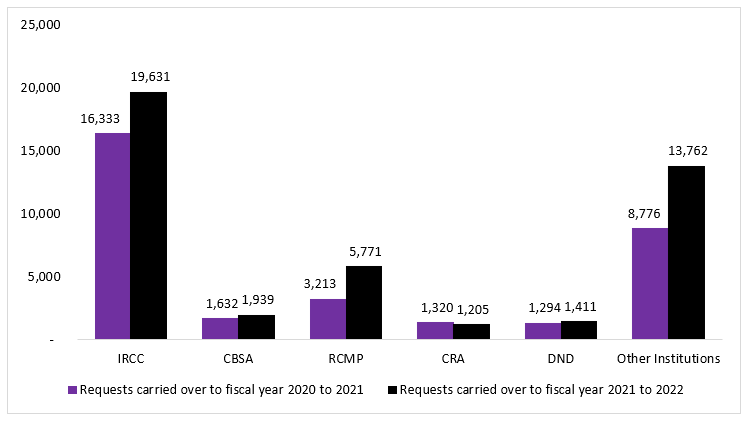
Timeliness
Of all the ATI requests that were closed by the five institutions who received the most requests in the 2020 to 2021 fiscal year, 70.1 percent were closed within legislated timelines, including extensions. This is an increase of 5.1 percent from the 2019 to 2020 fiscal year.
For all other institutions, of all the ATI requests that were closed in the 2020 to 2021 fiscal year, 66 percent were closed within legislated timelines, including extensions. This a decrease of 16.4 percent from the 2019 to 2020 fiscal year.

Requests under the Privacy Act
In the 2020 to 2021 fiscal year, five institutions received 76.3 percent of all Privacy Act requests received by all federal institutions. These five institutions are Immigration, Refugees and Citizenship Canada (IRCC), Employment and Social Development Canada (ESDC), Canada Border Services Agency (CBSA), Correctional Service of Canada (CSC), and the Department of National Defence (DND). To provide a more detailed understanding of the privacy program, this Annex provides data for these five institutions.
The number of requests received by the five institutions who received the most requests, decreased by 3.7 percent since the last fiscal year, from 59,008 in the 2019 to 2020 fiscal year to 56,851 in the 2020 to 2021 fiscal year.
The number of requests received by all other institutions decreased by 9.7 percent since the last fiscal year, from 19,533 in the 2019 to 2020 fiscal year to 17,643 in the 2020 to 2021 fiscal year.

The number of requests closed by the five institutions who received the most requests decreased by 6.8 percent since the last fiscal year, from 54,783 in the 2019 to 2020 fiscal year to 51,069 in the 2020 to 2021 fiscal year.
The number of requests closed by all other institutions decreased by 13.6 percent since the last fiscal year, from 19,447 in the 2019 to 2020 fiscal year to 16,796 in the 2020 to 2021 fiscal year.

The number of requests carried over by the five institutions who received the most requests increased by 21.9 percent since the last fiscal year, from 26,219 in the 2019 to 2020 fiscal year to 31,956 in the 2020 to 2021 fiscal year.
The number of requests carried over by all other institutions increased by 15.8 percent since the last fiscal year, from 5,438 in the 2019 to 2020 fiscal year to 6,296 in the 2020 to 2021 fiscal year.
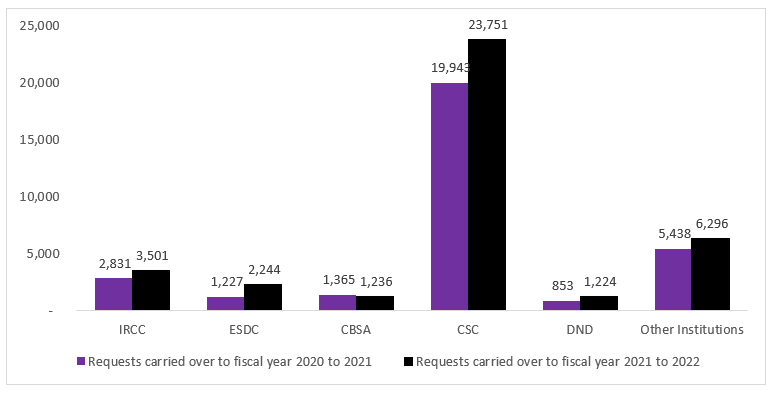
Timeliness
Of all the requests for personal information that were closed by the five institutions who received the most requests in the 2020 to 2021 fiscal year, 64.7 percent were closed within legislated timelines, including extensions. This is a decrease of 13.9 percent from the 2019 to 2020 fiscal year.
For all other institutions, of all the requests for personal information that were closed in the 2020 to 2021 fiscal year, 59.1 percent were closed within legislated timelines, including extensions. This a decrease of 20.8 percent from the 2019 to 2020 fiscal year.
